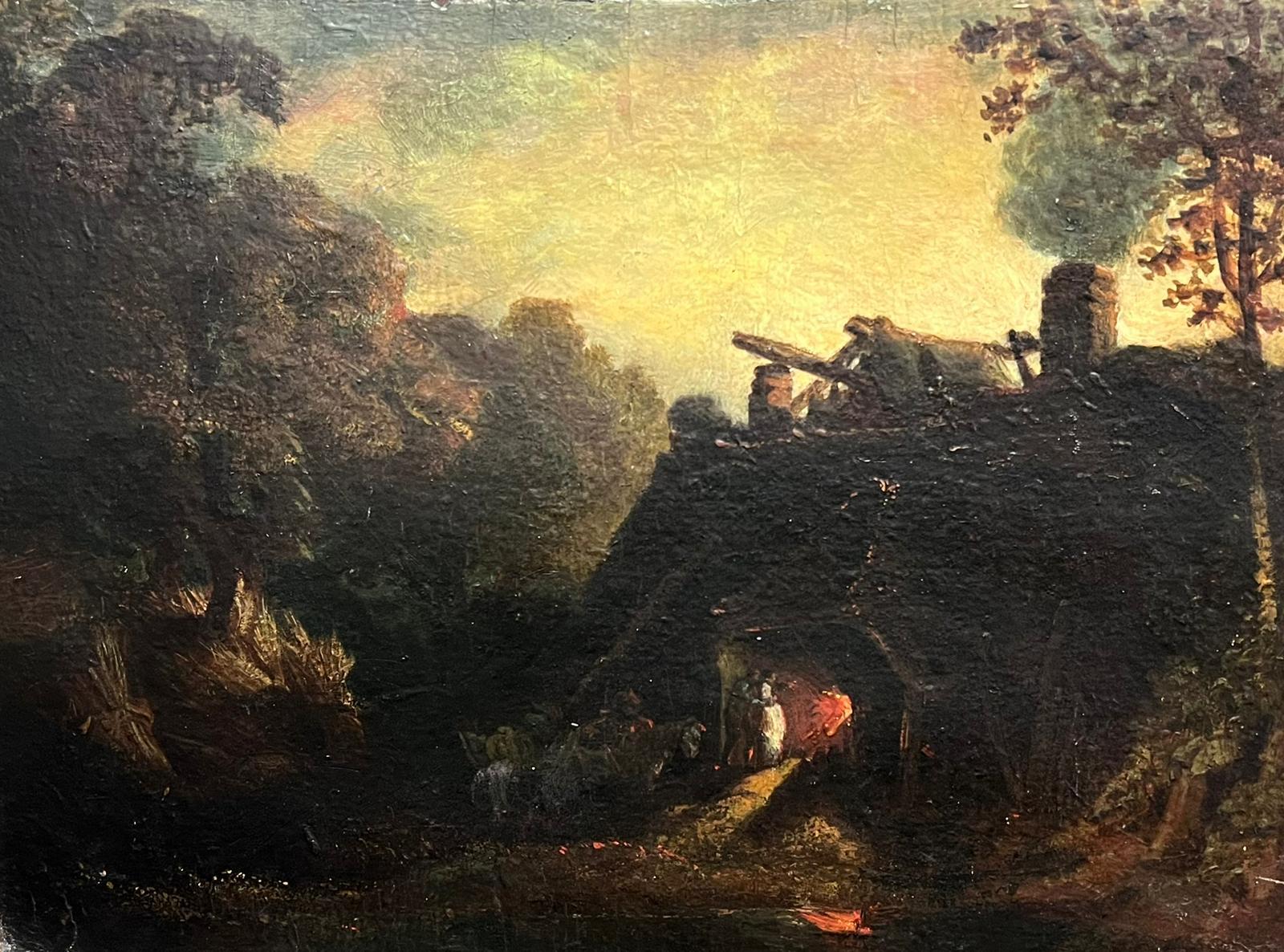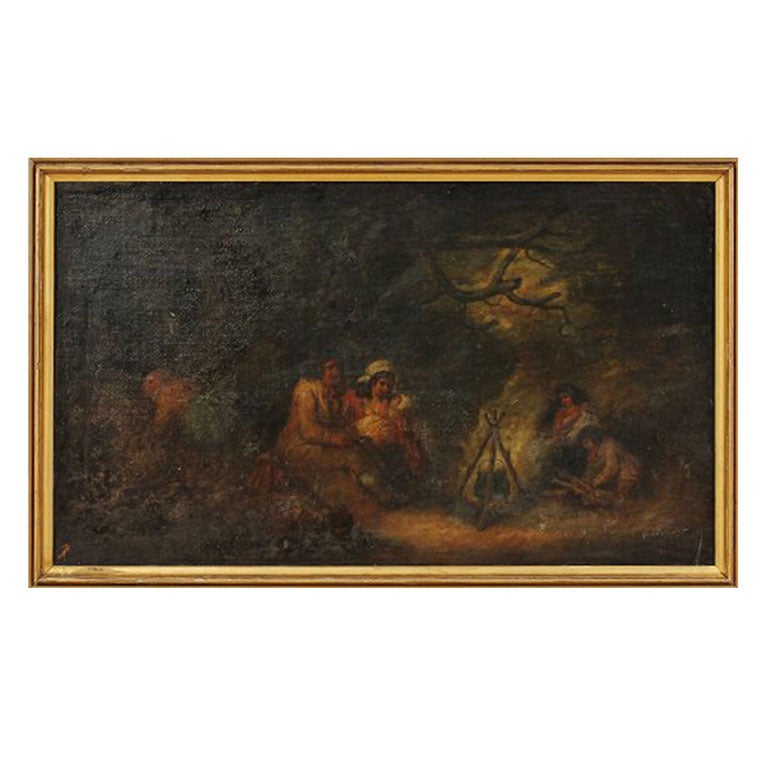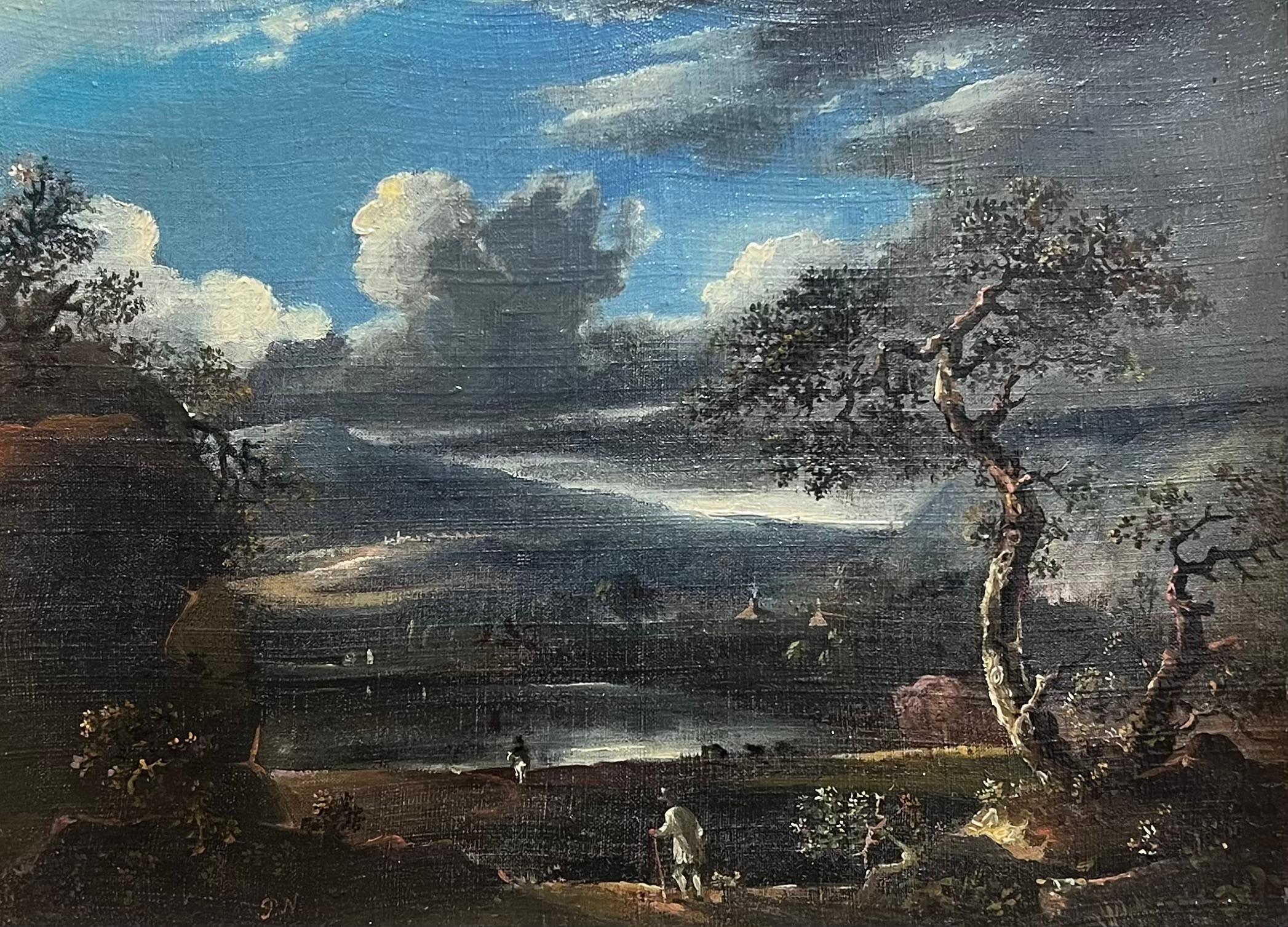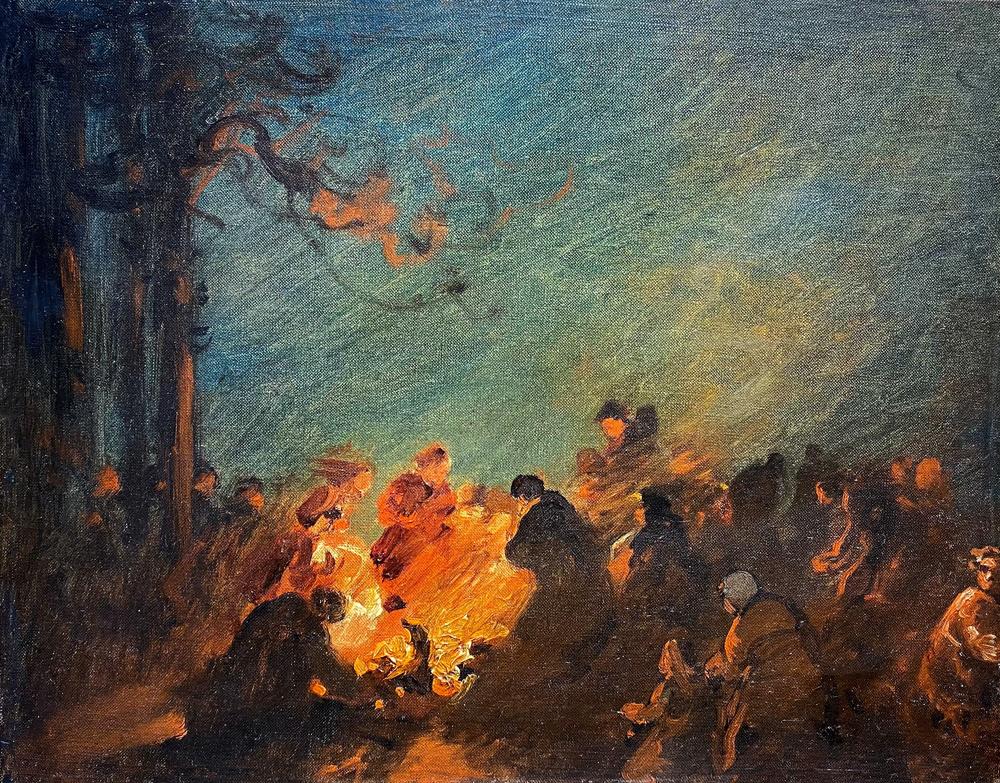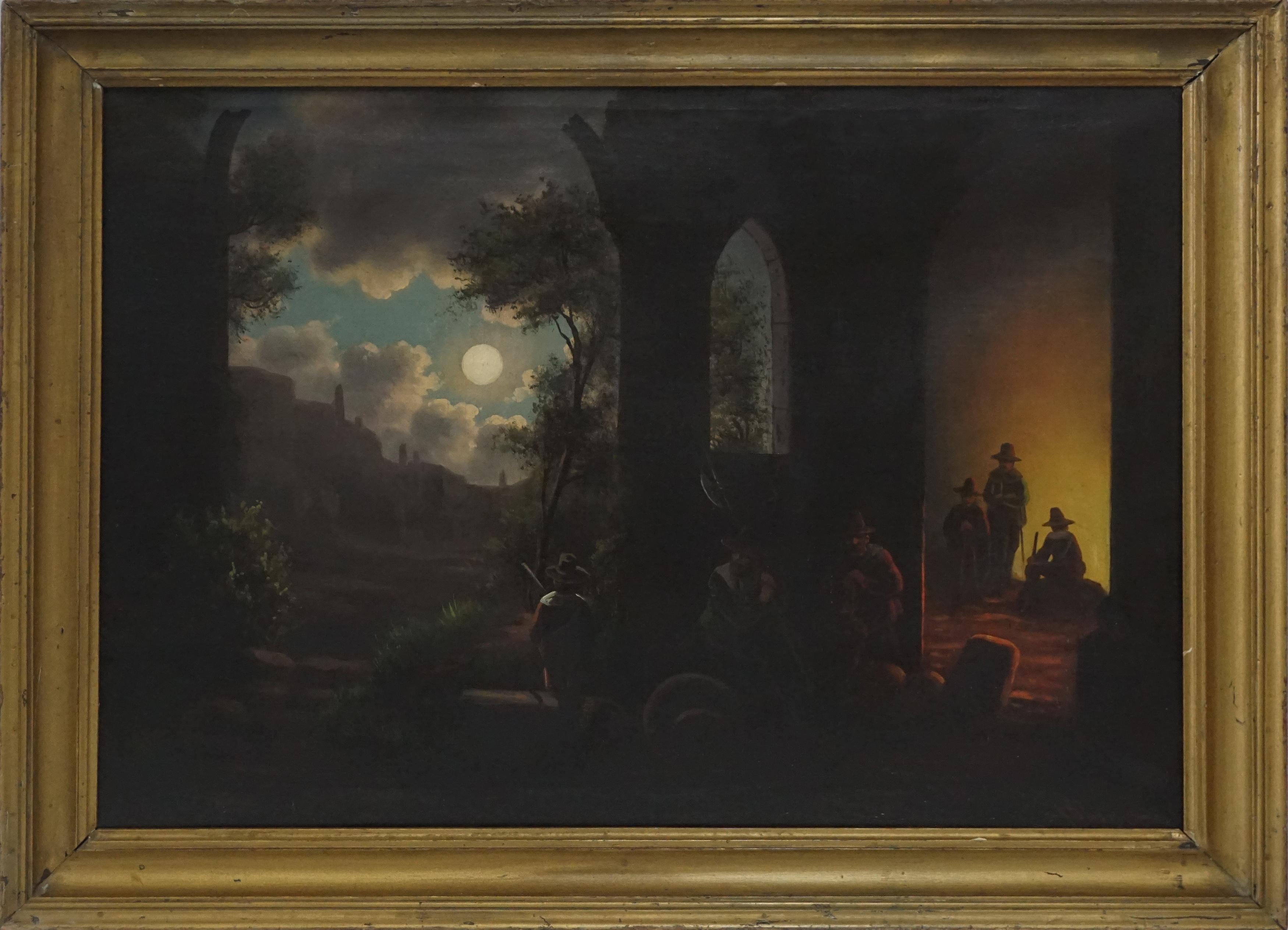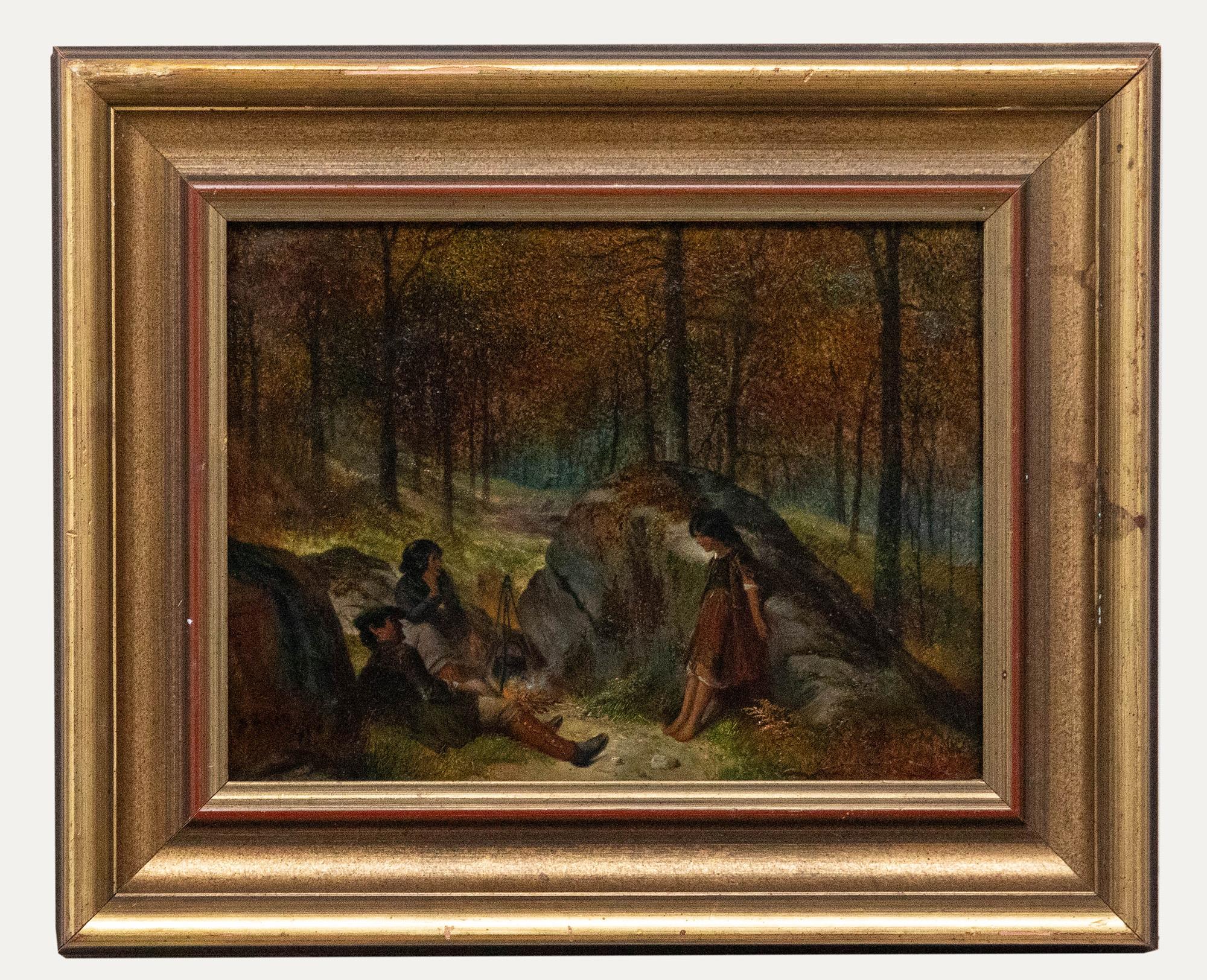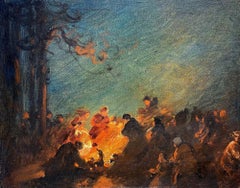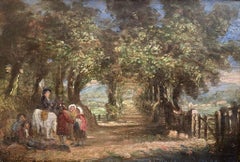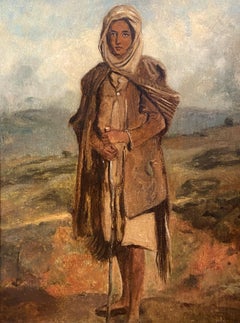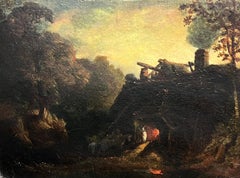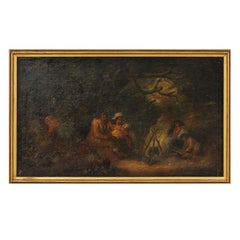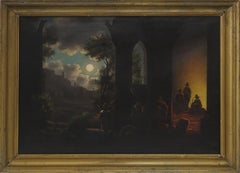Items Similar to Around the Camp Fire, 19th Century Oil Landscape Painting, Dated 1840
Want more images or videos?
Request additional images or videos from the seller
1 of 5
Around the Camp Fire, 19th Century Oil Landscape Painting, Dated 18401840
1840
Price Upon Request
Price Upon Request
Price Upon Request
Price Upon Request
Price Upon Request
Price Upon Request
Price Upon Request
Price Upon Request
Price Upon Request
Price Upon Request
Shipping
Retrieving quote...The 1stDibs Promise:
Authenticity Guarantee,
Money-Back Guarantee,
24-Hour Cancellation
About the Item
Oil on canvas, signed bottom right and dated '1840'
Image size: 22 x 30 inches (56 x 76.25 cm)
Albert Bierstadt
Recognized as the foremost painter of the American frontier during the nineteenth-century, Albert Bierstadt was born in Solingen, Germany, in 1830. At the age of two, he and his family emigrated to the United States, settling in New Bedford, Massachusetts. Nothing is known of his early art training; however, he might possibly have been influenced by local landscape painters. By the time he was twenty, he was supporting himself by teaching "monochromatic" painting and his work was beginning to attract the attention of New Bedford collectors.
In 1853, Bierstadt traveled to Düsseldorf in order to broaden his art education. It was there that he was associated with such American artists as Worthington Whittredge and Carl Wimar, all of whom frequently gathered in the studio of the German-American history painter, Emanuel Leutze. During this period, he was introduced to the work of Carl Friedrich Lessing and Andreas Aachenbach, contemporary German painters widely admired for their heroic, highly finished landscape compositions. Bierstadt quickly absorbed these stylistic conventions, eventually becoming the leading American representative of the Düsseldorf style.
While abroad, Bierstadt travelled along the Rhine, in the Alps and in Italy, often in the company of Whittredge, Sanford Gifford and William Stanley Haseltine. He returned to New Bedford in the autumn of 1857. In the following year, he made the first of his many contributions to the annual exhibitions of the National Academy of Design. In April of 1859, he joined the expedition along the Overland Trail, led by Colonel Frederick W. Lander, a trip that would soon give rise to the most productive and important phase of his career. Armed with sketches and stereographs, he returned to New York City in the autumn of 1859, establishing his studio in the Tenth Street Building. There he produced the first of the panoramic western landscapes that established his reputation on an international level and, during the mid-1860s, made him a rival of Frederick Church for the position of America's preeminent painter.
Indeed, because much of the continent remained still relatively unexplored at that time, Bierstadt's monumental renderings of stately mountains and cascading waterfalls created romantic visions of wanderlust in the minds of Easterners. His first public exhibition of these works in 1860 was a resounding success. Many critics deemed the viewing of his depictions as an almost "religious" experience, associating his mountain spires with majestic cathedrals, his luminous skies with the awesome power of God. As pointed out by Barbara Novak, such works represent the attitude of the "transcendental mind," one in which "all matter was an extension of God."
Bierstadt was elected a full Academician of the National Academy of Design in 1860. In the same year, he made several painting trips to the White Mountains as well as to the southern United States. He made a second trip to the West in 1863 which was followed by another visit to Europe in 1867. In 1871, he moved to California where he played an active role in the art life of San Francisco. In 1873, he returned to New York.
During the 1870s, Bierstadt executed a mural for the U.S. Capitol (1875) and in conjunction with the declining health of his wife, made the first of many trips to the Bahamas. He made a third trip to Europe in 1883. During 1889, he painted in both Alaska and British Columbia. He continued to produce landscapes throughout the 1890s. He also became involved in the promotion of various inventions, including his own designs for the improvement of railway cars.
Albert Bierstadt died in New York City in 1902. Although his reputation during the 1890s suffered slightly from the attraction for French art, his impact upon the American landscape tradition of the nineteenth century remains strong. His large-scale, panoramic landscapes, with their dramatic, almost sublime, light effects, coupled with the meticulous rendering of details, reflect the influences of both the contemporary landscape school of Düsseldorf as well as the native Hudson River School aesthetic. His works can be found in major public and private collections throughout North America and Europe, including the Metropolitan Museum of Art, the Wadsworth Atheneum, and the National Gallery of Canada.
About the Seller
5.0
Vetted Professional Seller
Every seller passes strict standards for authenticity and reliability
Established in 2007
1stDibs seller since 2014
82 sales on 1stDibs
Typical response time: 2 hours
- ShippingRetrieving quote...Shipping from: London, United Kingdom
- Return Policy
Authenticity Guarantee
In the unlikely event there’s an issue with an item’s authenticity, contact us within 1 year for a full refund. DetailsMoney-Back Guarantee
If your item is not as described, is damaged in transit, or does not arrive, contact us within 7 days for a full refund. Details24-Hour Cancellation
You have a 24-hour grace period in which to reconsider your purchase, with no questions asked.Vetted Professional Sellers
Our world-class sellers must adhere to strict standards for service and quality, maintaining the integrity of our listings.Price-Match Guarantee
If you find that a seller listed the same item for a lower price elsewhere, we’ll match it.Trusted Global Delivery
Our best-in-class carrier network provides specialized shipping options worldwide, including custom delivery.More From This Seller
View AllThe Campfire, 19th Century Oil Painting, English, Signed
Located in London, GB
Oil on board, signed verso
Image size: 10 x 15 inches ( 25.5 x 38 cm)
Original frame
Born in Liverpool in 1864 and raised in Manchester, Tom Mostyn, the son of the artist Edwin Mos...
Category
Early 20th Century English School Landscape Paintings
Materials
Oil, Board
The Journey, Late 18th English Oil Landscape
Located in London, GB
Oil on panel
Image size: 5 1/2 x 8 inches (14 x 2o cm)
Contemporary hand made frame
A charming scene of an English country lane, featuring a group of travellers resting on their journey. Two maids seem deep in discussion while they wait with a gentleman wearing a tricorn hat and fashionable maroon...
Category
Late 18th Century English School Landscape Paintings
Materials
Oil, Panel
The Bedouin, European School Oil Painting on panel, Original Frame
Located in London, GB
Oil on panel
Image size: 12 1/2 x 9 1/4 inches (31.75 x 23.5 cm)
Original frame
This is a captivating portrait of a young Bedouin. The painting has a sensitive and cohesive colour p...
Category
19th Century Figurative Paintings
Materials
Oil, Wood Panel
Evening Drink, Late 19th Century English Oil Landscape
By Frank Dean
Located in London, GB
Frank Dean
1865 - 1947
Evening Drink
Oil on canvas, signed and dated 1894
Image size: 29 ½ x 49 ½ inches
Handmade frame
Dean was born in Headingly, near Leeds, in 1865. He was a pup...
Category
Late 19th Century Landscape Paintings
Materials
Oil
Tempest 19th Century Oil British School
Located in London, GB
British School
19th Century
TempestOil on board
Image size: 9 1/2 x 12 1/2 inches (24 x 32 cm)
Category
19th Century Victorian Landscape Paintings
Materials
Oil, Board
Turkish Scene, 19th Century British School Victorian
Located in London, GB
British School
19th Century
Turkish Scene
Oil on board
Image size: 13 ½ x 10 ½ inches
Category
19th Century Victorian Landscape Paintings
Materials
Oil, Board
You May Also Like
Late 18th Century British Oil Painting Figures by Blacksmiths Forge Landscape
Located in Cirencester, Gloucestershire
The Blacksmiths Forge
British artist, late 18th century
Circle of Julius Caesar Ibbetson (1759-1817)
oil on board, unframed
board: 11 x 14.5 inches
provenance: private collection, En...
Category
Late 18th Century English School Landscape Paintings
Materials
Oil
Oil on Canvas, 19th Century Unknown Artist, Fireplace with Women and Children
Located in København, Copenhagen
Oil on canvas. 19th century, unknown artist, fireplace with women and children.
Good condition, 57 x 101 cm. The gold frame is in good condition.
Category
Antique 19th Century Unknown Paintings
$1,440 Sale Price
20% Off
Free Shipping
Early 1800's British Oil Painting Figures in Brooding Nocturnal Hilly Landscape
Located in Cirencester, Gloucestershire
The Windswept Sky
Attributed to Patrick Nasmyth (Scottish 1787-1831)
oil on canvas laid over board, framed
Framed: 14 x 17 inches
painting: 11 x 14 inches
Provenance: private collect...
Category
Early 19th Century English School Landscape Paintings
Materials
Oil
18th Century European School Original Oil Painting -- Soldiers at Rest
Located in Soquel, CA
18th Century European School Figurative and Landscape Painting of Soldiers at Rest
Evocative Dutch School painting of soldiers resting at end of day in old ruins, signed J. Kamp (D...
Category
Early 19th Century Other Art Style Figurative Paintings
Materials
Linen, Oil, Stretcher Bars
Samuel Baldwin (1818-1891) - 1891 Oil, Camping in the Woods
Located in Corsham, GB
By Samuel Baldwin of Halifax. Signed to the lower right. Presented in a gilt frame. On board.
Category
Late 19th Century Landscape Paintings
Materials
Oil
$376 Sale Price
20% Off
19th century English forest landscape with figures by a fire side, mid afternoon
Located in Woodbury, CT
19th century English forest landscape with figures by a fireside, mid-afternoon.
A very well painted classic Victorian English landscape with figures. Wonderful observation by the p...
Category
1850s Victorian Figurative Paintings
Materials
Oil
$3,465 Sale Price
30% Off
Free Shipping
More Ways To Browse
Antique Fire Signs
Alaska Painting
19th Century Large French Oil Painting
19th Century California Paintings
Alaska Landscape Art
19th Century Settle
Antique Native American Painting
Paintings Of The Alps
19th Century Landscape Hudson River School Paintings
19th Century Oil Paintings Religious
Rhine Art
Alps Oil Painting
Antique Canvas San Francisco
French Alps Landscape
Mountain Painting Alps
Stanley Antique
19th Century Western Oil Paintings
Solingen Germany
